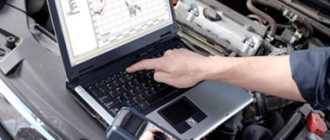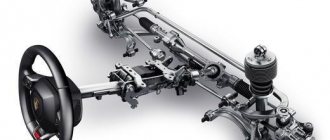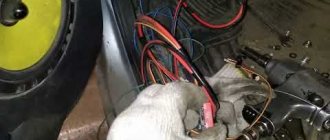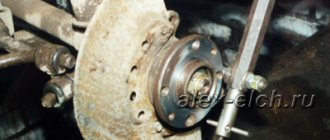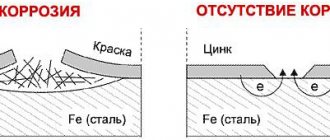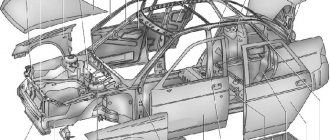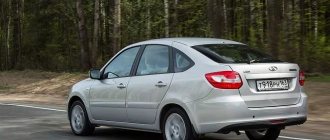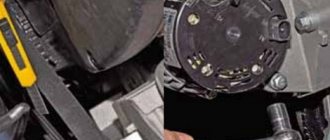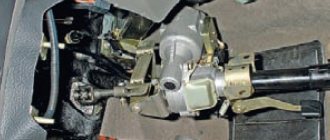The essence of the problem is this: today I was driving on business in the evening, on a flat and smooth road, over a bridge. the speed was about 100-110, and suddenly the steering wheel began to shake. vibration in the body. as if the wheel had broken. has stopped. the wheels are ok. Moreover, from a hundred I gradually dropped to 60-70, I couldn’t stop right away, because the bridge. With grief I reached the place, keeping the speed in the region of 40-60, the vibration was felt, but not as strong as at first. Two hours later I was getting ready to go back, there was zero vibration at speeds up to 90, I didn’t accelerate it higher. I drove off, after 10 minutes the vibration started again, at first small, and after 20-25 kilometers it became stronger and at a lower speed (about 40) What could be the problem? The car is of this year, mileage 10,500.
I can offer several options: 1. The wheel nuts are not tightened properly. Try to stretch it out. It was like that myself. I forgot to tighten one wheel when I changed to summer shoes, and on the bridge it began to pound so hard that it became scary. I couldn’t stop either, I drove off the bridge, stood up, looked, picked up my jaw, took out the spray bottle, held it out, thought about life. 2. The disk is bent. Usually the inner side is wrinkled, remove the wheels and inspect. Maybe something with the rubber... 3. Wheel bearings (less likely, usually does not hit) 4. Steering rods (tips) or balls. Check that the steering wheels are in a standing position (we roll the wheel left and right (left towards you, right away from you and vice versa)). Ball wheels - hang them up, preferably on a lift, swing the wheel as in the previous case, only up and down. 5. The brake discs were deformed (I drove into a puddle after intense braking). But then the beating would only occur during braking and would be felt on the pedal... 6. Rake (unlikely). When standing, shake the steering wheel, it’s normal - no knocks, etc. there should be no sounds. 7. Check the tightness of the steering knuckle fastenings to the strut and, in general, all connections in the front suspension (fastening the lower arm, etc.). It seems like everything I could come up with...
Wheel imbalance
This is one of the most common causes of steering wheel wobble at speed. If one or more wheels are not balanced according to requirements, the driver will constantly feel at speed that the steering wheel vibrates a little. Moreover, in such a situation, runout can occur at both low and high speeds, and can also be constant.
Very often there is a beating of the steering wheel when the engine reaches a certain speed. As a rule, this is explained by the fact that the load in the wheels of the car is shifted for balancing and unauthorized alignment occurs. When the engine slows down, the problem disappears by itself.
For understanding, let's give an example of a centrifuge from a regular washing machine. If the clothes inside are placed incorrectly and unevenly, then when the speed increases, strong vibration will occur, which disappears at high speed. The fact is that centrifugal force comes into play and normalizes the center of gravity, and the things inside are distributed independently. The same can be said about a car.
The solution to this problem of runout is to visit a service station and have the wheels balanced. It should be noted that before embarking on such a procedure, wash the discs well, since if there is dirt on them during balancing, its effect will soon fade away. Also pay attention to the condition and position of the weights, which should be close to each other on each side.
Checking the ignition system
In some cases, the car starts to jerk due to some kind of malfunction in the ignition system. As a rule, the problem can be caused by untimely ignition of the fuel mixture. In rare cases, this is due to a weak spark from the spark plug, which in turn is due to low voltage supplied.
Why does the VAZ-2114 jerk when driving? To do this, during diagnostics it is necessary to check:
- First of all, the performance of the ignition coil.
- Serviceability of spark plugs (it is worth noting that if these elements malfunction, they are replaced as a complete set!).
- Pay attention to the condition of high-voltage wires.
- Are there any problems with the distributor (ignition distributor).
- Condition of the camshaft and crankshaft sensors.
And if the problem is the spark plug, then this is a fairly common and mild case. This type of breakdown is harmless and even a beginner can cope with it. Sometimes the problem may be caused by an incorrect gap between the spark plug contacts, which does not meet established standards.
But if the camshaft position sensor is to blame, then you won’t be able to start the engine at all. In this case, qualified assistance from specialists is necessary.
Installing non-compliant drives
Trying to somehow improve the appearance of their car, many owners install some original and unusual wheels, often forgetting to pay attention to their compliance with technical parameters.
If the discs are not suitable for a specific car model, then over time this will lead to the destruction of suspension elements due to increased load, the formation of play at the joints and, ultimately, the steering wheel wobble.
Excessive contamination of the wheels also has a negative impact, which leads to their imbalance.
Supply system
As a rule, the main reason that the VAZ-2114 car jerks when driving is due to a malfunction of the power system.
Usually, experienced car enthusiasts and auto mechanics try to look for the cause here first, and they will be right. While the vehicle is starting to move, insufficient fuel may be supplied to the cylinders. This leads to the development of low power, which is not enough for full operation of the transmission.
In other words, if there is an uneven supply of the fuel-air mixture in the power unit, then it will simply not ignite well. In turn, because of this, the timing of the explosion is disrupted, and the heart of the car begins to malfunction. The driver feels this, which causes a lot of discomfort while driving. What can be done:
- Check the functionality of the hall sensor.
- Pay attention to the position of the throttle valve.
- The condition of the injectors also deserves attention.
In addition, to understand the reason why the VAZ-2114 injector twitches when driving, it is necessary to evaluate the condition of each element of the fuel system. Moreover, regardless of the type of power unit. As experts note, due to depressurization of the pipes, the engine experiences fuel starvation. This is manifested by failures in engine operation. Therefore, it is better not to neglect a thorough check of the pipes!
Hub destruction
In some situations, the steering wheel may twitch only when accelerating, while in stable motion there will be no problems. Typically, this can be caused by damage to the hub that the wheel is attached to. The reasons may be different: a strong blow or a banal failure of some element of the car’s suspension.
If steering wheel wobble when driving at speed appears during turns, then it is quite difficult to find out what the problem is, since a large number of connections and assemblies are involved in the maneuver. The reasons may be in tie rod ends, rods, bearings and much more. Any such breakdown can cause the steering wheel to jerk. Only service specialists can help and effectively fix the problem after diagnostics and inspection.
Air filter?
As is known, the formation of an engine working mixture requires a certain amount of air in which oxygen is present. And without it, the combustion process itself is impossible. In a car, before entering the working chamber, the air passes through the labyrinths of the filter and only after that it combines with the fuel mixture, forming just the working composition.
However, if this element is contaminated, the car may also begin to jerk while driving or when starting off. As a result, the flow decreases significantly and there is simply no longer enough air in the required quantity. This risks the working mixture becoming rich in fuel and burning incorrectly.
As a result of this, the VAZ-2114 jerks when driving, and in some cases there may be misfires.
Ways to solve the problem
If you suddenly feel that the steering wheel is vibrating a little at speed, then do not rush to go to a service station and waste your money. Considering the reasons that cause the steering wheel to wobble, you can try to eliminate it yourself. To do this, follow these steps:
- Check the tire pressure and adjust it to normal if necessary.
- Carefully inspect all wheels for damage. Perhaps this is precisely the problem, and the beating is caused by a dent, crack, etc.
- Check all bolts and tighten them if necessary.
- Change the wheels on the front and rear axles.
- Raise the car and reach the speed at which the wobble begins. This way you can figure out which wheel is having problems. After that, remove the required disc, and again pick up speed, while simultaneously observing the brake disc. If the vibration does not disappear, then the CV joint or the disk itself may be faulty.
Steering wheel vibration: 35 reasons
Steering wheel vibration can occur for many reasons.
Let's look at the main ways to identify and eliminate them. Steering wheel vibration while driving
https://www.youtube.com/watch?v=X943YHyFcHU
The causes of steering wheel vibration at low (20 – 30 – 40 km/h), medium (50 – 60 km/h) or high (100 – 110 – 120 km/h) speeds are:
- tire defects;
- wheel rim defects;
- errors during tire fitting, balancing and fastening of wheels;
- malfunction in the drive of the steered wheels;
- operational reasons and regulatory deviations;
- influence of external forces;
- wear or damage to parts that determine the geometry of the suspension, the position of the wheel, and the rigidity of its connection with the steering wheel.
Let us examine in detail the main root causes.
Vibration of the steering wheel at speed due to imbalance of the wheels (primarily the steering axle wheels) occurs due to the following primary reasons:
- incorrect wheel balancing in a tire service (random error or the result of low qualifications of the performer, malfunction of the balancing machine);
- disconnection of the balancing weight due to improper fastening or external influence;
- dirt or ice between the spokes of the disc or on the shelf (usually on the inside);
- uneven tread wear as a result of manufacturing defects or general low quality of the tire;
- uneven wear of the tire tread on one axle as a result of incorrect wheel alignment angles;
- getting into the tread of the tire and holding a massive foreign object (key, bolt, etc.);
- uneven circumferential loss of studs on studded winter tires;
- accumulation of rubber chips inside the tire on one side after driving with completely flat tires.
Steering wheel vibration at high speeds (100 – 110 – 120 km/h) most often occurs due to wheel imbalance.
Steering wheel vibration due to deviation from the correct geometric shape of the tire. It can be either irreversible or temporary. Temporarily this manifests itself in the following main cases:
- violation of the optimal order for storing wheels (both new ones, during delivery and storage before their purchase and initial installation, and used ones, during off-season storage);
- long-term parking in severe frost (a flat “shelf” is formed in the lower part, the “kneading” of which requires a run of several hundred meters to a couple of kilometers).
For these reasons, vibration of the steering wheel at speed begins almost from the very beginning of movement, but over time the tire “warms up” and returns to its normal shape, the vibration and noise disappear.
Deviation from the correct shape of the tire becomes irreversible as a result of the following reasons:
- internal tear of the tire cord due to external influence (for example, after hitting a curb, etc.), which over time, with continued operation, leads to the fact that the dynamic nature of steering wheel vibration is aggravated by imbalance due to intense uneven wear of the tread;
- uneven wear due to a factory defect in the tire that appears over time during normal use;
- incorrect alignment angles of the wheels (or one wheel), which causes a change in the balance of forces and also, over time, leads to local wear and loss of balance.
Shape deviation is detected by visual inspection of runout when the wheel rotates, and uneven wear is detected by measuring the tread height (groove depth) in several places along the diameter and width of the tire. A defective tire must be replaced.
Vibration of the steering wheel due to deviations in the geometry of the wheel rim is also possible in several cases:
- as a result of a strong impact of the wheel (on a curb, the edge of a hole in the road surface, during an accident, etc., which can also be further facilitated by insufficient tire pressure);
- due to the insufficient strength of the disc due to its poor quality, even with moderate dynamic movement on uneven surfaces;
- as a consequence of a rare manufacturing defect, in which the positioning planes of the disk in the standard mount on the car and behind the central hole in the balancing machine are different (after precise balancing, runout appears on the car).
New Lada: Lada Granta 1.6 MT Standard (06.2017 - 07.2018)
Often, a change in the shape of the disk can be noticed visually, both statically and during manual rotation of the raised wheel, without removing it from the car, but a more reliable and accurate way is to check it at a service center. The method of eliminating the defect consists of rolling it on a special machine or replacing the disk with a new one, depending on the conclusion of competent specialists based on the results of the inspection in each specific case.
Steering wheel vibrations due to problems with wheel mounting and wheel fasteners can also have several root causes:
- loosening (unscrewing) the fasteners until a gap forms between the wheel disc and the contact plane of the brake disc/drum;
- discrepancy between the geometry of the fastener and the disk holes, in which the disk is unevenly positioned relative to the hub axis and is thus tightened during fastening;
- the entry of a foreign object (usually dirt) onto the contact plane under the disc, which also disrupts the correct positioning of the wheel when tightening the fastening.
Unfortunately, incomplete tightening of the fasteners is not so rare when rearranging the wheels yourself; this also happens in the service. In this regard, it is very reasonable for every driver to adopt a mandatory procedure for checking the tightening after installing the wheel, before starting to drive and after several kilometers of driving. You don’t have to do the inspection yourself - you can contact another employee or the nearest tire service.
Steering wheel vibration due to incorrect selection or installation of tires occurs as a result of the following situations:
- different tires on the same axle (for example, discrepancies in size or permissible load with the same size);
- incorrect setting of the direction of rotation of one of the wheels with a directional tread pattern.
These reasons are identified by visual inspection of the markings on the sidewall of the tire and careful comparison with similar data on the tire on the other side of the car. The following are subject to comparison:
- full name of the brand and model, including such name elements as the designation “SUV” (for crossovers), generation (“2”, etc.) and others;
- linear dimensions of the tire - width and height of the profile (for example, 225/50);
- load index (for example, 94, 97,...105, etc.);
- speed index (for example, U, H, V, W, etc.);
- direction of rotation, which is indicated by an arrow and the inscription “Rotation”);
- side for installation - external (inscription “Outside”) or internal (Inside);
- other markings (for example, XL or Extra Load - reinforced tire) may be indicated.
The probability is small, but it is better to make sure that there is no error in the selection and installation of tires. Some tire manufacturers produce tires of certain models in the same size, but of different designs (for example, in terms of permissible load), which creates the conditions for the described situation.
Steering wheel vibration due to worn or damaged mating components:
- critical excess of permissible play in the steering (for example, in steering tips), as a result of which the wheels begin to “walk” freely and transmit shocks when the play is selected;
- loosening of the steering rack fasteners;
- bending of the drive shaft in the transmission;
- bending of the steering shaft or wear of the cardan shafts in its joints;
- wear of the CV joint or lack of lubrication in it;
- wear of wheel bearings on the front (steered) axle;
- critical wear and the appearance of play in some wheel suspension components - silent blocks, strut supports, etc.;
- violation of body geometry or bending of suspension parts as a result of an accident or other similar event (hub, suspension arms, etc.).
New Lada: Why the Lada Granta FL central locking does not close the passenger doors » Lada.Online - all the most interesting and useful about LADA cars
Identifying problems with steering wheel vibration due to the internal CV joint can cause certain difficulties.
Steering wheel vibration in place
Most often, vibration, felt not only on the steering wheel, but throughout the entire body, when the car is parked in place with the engine running, is a consequence of several main reasons:
- wear of power unit supports;
- unstable engine operation at idle;
- errors in installing the engine after a major overhaul or replacement;
- the entry of a solid foreign object (for example, a stone) between the engine crankcase and the protection, through which vibration from the engine is transmitted to the body and to the steering wheel as well.
Steering wheel vibration when braking
Steering wheel vibration during braking occurs when the working surfaces of the brake discs/brake drums warp. Most often, such deformation occurs when water gets on steel or cast iron parts overheated by intense braking (for example, driving into a puddle immediately after active braking), as a result the working surface becomes wavy.
The solution is to replace the disks with new ones or, sometimes, to re-groove the deformed ones, depending on what seems more profitable based on the condition and remaining thickness of the disk, prices for spare parts and labor.
When considering the option of grooving the brake drum, you need to be aware that grooving the inner working side will lead to the formation of an imbalance in the part.
What to do if you notice steering wheel vibration
The sudden appearance of steering wheel vibration at speeds of 100 – 110 – 120 km/h is a dangerous situation. It is necessary to immediately take measures to stop, without making sudden actions in the form of quickly turning the steering wheel to the side of the road or emergency braking. For example, vibration of the steering wheel while driving is caused by the fact that the wheel is held on by several threads of the wheel fasteners or the fasteners have fallen off altogether, and the wheel is held only by the central hole on the hub protrusion. Driving or braking suddenly in such a situation will lead to the loss of a wheel with the risk of an accident.
Once stopped, you can inspect and check in the following sequence:
- without making significant efforts, on the spot (without moving the car) evaluate the free rotation of the steering wheel before the wheels begin to turn - an unusually large play will indicate the primary direction for troubleshooting in the steering;
- carry out an external inspection of the completeness and check the tightness of the wheel fasteners;
- check tire pressure with a pressure gauge;
- alternately, on the left and right sides, lift the car on a jack until the steering wheel lifts off the surface and rock it in the vertical and horizontal planes, first assessing the play of the wheel bearing and listening to knocks in the suspension and steering;
- Without lowering the jack, inspect the integrity and correct shape of the rims and tires, the presence of foreign objects in the tread of the tires, the attachment points of the balancing weights (they will stand out clean if the weight has just fallen off), pay special attention to the shape of the inner side of the rims (more often it wrinkles lighter than the outer edge), evaluate the play in the steering tips;
- Without lowering it from the jack, spin the wheel by hand and observe how smoothly it rotates on the outer surface in the tread area.
If the cause is not determined and corrected as a result of an independent inspection on the road, then it is better to call a tow truck to deliver the car for service, since continuing to drive can be extremely dangerous.
New Lada: How to disable the Lada Granta immobilizer?
If vibration of the steering wheel at speed occurred immediately after visiting a tire service center, then most likely the negative phenomenon was caused by the work carried out there and the cause should be sought first of all by inspecting the wheel fastenings and checking the identity of the tire markings, the correctness of their installation, and checking the air pressure in the tires. You can lift the car on a jack and inspect the runout when rotating the wheels by hand.
If steering wheel vibration has developed gradually over a long time, then you need to check almost all of the possible root causes listed above, including wear in the CV joint, wheel bearings, etc.
If the steering wheel vibrates when cornering, you should immediately pay attention to the condition of the CV joint.
Steering wheel vibration should not be ignored, because... As the situation develops, extremely unpleasant, dangerous and expensive consequences can occur, from tires becoming unusable to a serious accident.
Steering wheel vibration can be a consequence of deviations in the condition of tires or rims, or for a number of other reasons, including those associated with wear or damage to other components. Some of the reasons can be identified and eliminated with your own hands, while some are quite difficult to identify and will require contacting service.
A fairly common car malfunction is vibration of the steering wheel at a speed of 90-100 km per hour. At low speed everything may be fine. But as it increases, the steering wheel begins to “come to life” in your hands. And even when driving on a flat road. It often happens that this phenomenon appears gradually, from a small, barely noticeable vibration to real trembling, when not only the steering wheel, but also the column shakes.
Following this, the instrument panel and interior trim rattle so much that it becomes impossible to drive. It is worth noting that this problem appears not only on domestic cars, but also on many foreign cars. Commercial vehicles, for example, Gazelle, are no exception. When steering wheel vibration appears at a speed of 90-100, the main reasons can be very different. So let's look at them in detail.
How can you solve the problem?
Some will take their favorite car to a service station. However, this should only be done when there is a reliable specialist who knows his job well. Otherwise, there is simply no guarantee that the source of vibration will be detected and the problem will be solved. Even in the event of such troubles (and they occur very often), repair specialists can charge a high price for the work. The driver may also pay for unnecessary operations. For example, a service station offers to replace the entire steering mechanism completely. Doing this is much easier than figuring out why the steering wheel shakes at low speed. The owner should be well aware of the reasons for this behavior - then he will not need the help of the service. You can almost always fix the problem yourself.
Engine mounts, tie rods and other problems
There is another group of problems that cause vibrations when accelerating a car. It is difficult to collect these problems into one bundle, because they are all different and arise for various reasons. Vibration often occurs when one of the engine mounts is broken. This can easily be checked by increasing the speed while shaking.
The gearbox may also be the culprit for this type of problem. If the car starts to shake at 80 kilometers per hour, you can very easily check the fault of the gearbox by performing the following procedures:
- accelerate to a speed of about 85 kilometers per hour;
- depress the clutch and observe the vibration change;
- engage third gear and smoothly release the clutch;
- try accelerating from 50-55 kilometers per hour in last gear.
If the nature of the shaking does not change in all these experiments, the box has nothing to do with this problem. If there is more shaking when the gearbox is engaged, you will have to check whether it is involved in this problem.
You can also check the automatic transmission. At a speed of about 85-90 kilometers per hour, it is enough to switch the gearbox selector to modes 3, 2, D, N and observe the operation of the box itself and the change in vibrations. Often the gearbox is not to blame for the vibration of the car body, but there are such cases.
For useful tips on some possible causes of shaking, watch the video:
Balancing disorders
Tires and rims are not ideal either in terms of geometric characteristics or composition. And since the weight of these elements differs in some parts, then at the moment the wheel rotates, the point where the weight is greater will pull the center of the wheel towards itself. This is the effect of centrifugal force. Even at low speeds (and already at 40 km/h the wheels rotate quite quickly), vibrations will come to the steering wheel through the rods. Wheels must be balanced. This is done after replacing tires or wheels. The essence of the process is that the mass of the wheel is the same at each point. To do this, special weights are attached to the disk.
Wheel alignment and tire quality are another reason for shaking
If the wheel alignment angle is incorrect, vibration, the car pulling to the side, uneven eating of rubber and other unpleasant manifestations are possible. In different models, these problems manifest themselves in different aspects. Adjusting the wheel alignment angles is one of the first processes that needs to be performed after detecting such a nuisance as body vibration.
Problems can also be caused by tires that are worn incorrectly, or a disc after a serious impact. The main processes that can be taken to eliminate body vibration in this case are as follows:
- adjusting the wheel alignment angle at a wheel alignment station;
- replacing tires if there are visual indicators of uneven or excessive wear;
- replacing or repairing a disc that shows dents and uneven rims;
- performing wheel balancing - often during operation the balancing weights fly off.
Symptoms of imbalance
The main symptoms are the steering wheel shaking at low speed. But vibrations can also be felt at higher speed ranges - from 60 km/h and above. It is necessary to carefully inspect the tires and wheels. The discs must be smooth and without deformation. If your driving style is calm and careful, and the tires are not too worn, then the cause is imbalance. What to do in this case? Balancing only the front wheels if there are vibrations only on the steering wheel is the wrong approach.
"Personal" motives
The cases listed above are the main reasons why the steering wheel twitches when driving a VAZ-2114. Moreover, this is observed when starting or accelerating. However, it should be taken into account that each vehicle has individual characteristics, which are comparable to the human body.
In other words, each car has its own “diseases” and the appearance of the “symptom” in question is precisely due to the presence of design flaws.
Even if car enthusiasts react quite nervously to such common phenomena as the rattling of glass and plastic inside a car, vibration of the steering wheel can put almost every driver in a mental hospital - this is a very annoying and unpleasant process. Jokes aside, vibrations on the steering wheel are a very serious problem. Today we will find out the reasons for its occurrence and tell you how to cope with this disaster.
Causes of vibrations on the steering wheel
As a rule, vibrations in the steering wheel appear under various conditions: when the car is moving at different speeds, braking, or when the car is stationary and its engine is idling. If the beating of the steering wheel has become annoying, you need to determine in what circumstances it manifests itself, and depending on this, diagnose the cause.
Steering wheel wobble when the car is stationary
Vibrations in this case can occur for two reasons: due to loose engine mounts or due to problems with the steering rack drive shaft. In the first option, when the engine is idling, the steering wheel hits quite hard. Such vibrations appear on cars with high mileage: either the mountings of the power unit have become loose over time, or the engine was not installed properly after a major overhaul. If even at low speeds a significant beating of the steering wheel is felt, then as the speed increases, the vibrations increase and driving such a car becomes not only uncomfortable, but also unsafe.
The second option: the occurrence of vibrations at idle speed in a stationary car can be caused by wear of the splined part of the steering rack drive shaft or deformation of the shaft itself. With this option, the steering wheel runout may also increase when the car moves.
You cannot drive with such vibrations for a long time because it can lead to destruction of the steering mechanism elements, and, as a result, loss of control of the car - an accident.
Steering wheel vibration when driving at different speeds
Here there are more factors causing vibrations, and they are mainly related to the condition of the wheels.
Firstly, steering wheel beating can occur due to the fact that the wheel rims become clogged with snow or dirt, which leads to imbalance of the wheels and, as a result, the appearance of those same annoying vibrations. In this case, the steering wheel only shakes at low speeds, and when the speed increases, the vibrations disappear completely.
Disc deformation
As already noted, they are far from ideal in their geometric characteristics. And how curved the wheels are greatly affects the behavior of the car. Wheel rims may become deformed due to the vehicle falling into a hole. Curvature can be detected visually. It is necessary to carefully inspect the rim for dents. But most often the inner part of the wheel rim is bent. Stamped products are most susceptible to deformation. Cast ones are destroyed to a lesser extent. The wheel rim may change its geometry during operation, or may be uneven initially. This is determined at a special stand. But there is a problem here - often on such equipment the wheel behaves correctly, but when driving a car it rotates unevenly. If the disk behaves this way, then it is clearly defective.
Other breakdowns that cause interior vibration
But it’s not for nothing that the list of possible faults includes the item “Other technical flaws”. Just because some problems are more common than others doesn't mean they don't happen. That is why it is better to carry out a full diagnosis of the car when vibrations occur in the cabin.
Burnt-out diodes, pebbles and plants getting stuck in parts, friction of parts against each other, tilting of the engine and dents on the body - these are just a small part of those minor faults that can cause unpleasant trembling of the body and disrupt the operation of the engine. Fixing them doesn't take much time if you know how to do it yourself. A car service would not be the best solution. Once mechanics become aware of annoying vibrations, they may force you to replace already functioning parts.
Having bought a car, you should be prepared for the fact that you will have to learn how to understand it if you do not want to leave huge sums of money in car repair shops. This is especially true for VAZ, which likes to annoy drivers with all sorts of breakdowns, from slowly working wipers to body vibrations. You must always carefully monitor your vehicle if you do not want to stop in the middle of a busy road and cause a lot of inconvenience to others.
Tires
The steering wheel shakes when driving at low speed due to the tires, or rather their quality and condition. The cord, the metal braid that is located inside the tire, is often damaged. As a result, part of the tire becomes convex, which causes beating. Another equally popular tire problem is bumps. They appear on the sidewalls of the rubber due to careless driving, driving on potholes or rails. Well, you can’t cancel a factory defect. He can express himself in a variety of ways. If it hits the steering wheel at low speed, the problem can be solved by replacing damaged disks and tires.
Vibration when accelerating
This is terrible, especially when you need to accelerate quickly, for example if you need to overtake another car. Often when you press the pedal, acceleration is jerky and uneven. To make a correct diagnosis, you need to follow a few simple steps.
Check the oil level in the gearbox. Surprisingly, low transmission oil levels cause vibrations and shaking during acceleration. The car may also noticeably lose its dynamic characteristics. Jerking when pressing the accelerator pedal - this can also be a consequence of a lack of oil.
A dirty automatic transmission filter leads to various unpleasant effects. You can do the replacement yourself or use the services of specialists.
A worn driveshaft is a guaranteed noticeable vibration of the car when accelerating. The weak point here is the cross. Replace the part if necessary, otherwise it may cause more serious damage.
Also, such a nuisance can be caused by uneven engine operation. This often happens after renovations. Sometimes service station professionals simply forget to balance the crankshaft and flywheel. Another reason is an incorrectly configured carburetor.
Weak wheel fastening
This reason is very dangerous. If the wheel fastening becomes loose and the owner does not notice it in time, the wheel may fall off the hub while driving. The safety of the driver and passengers will be at risk. When the steering wheel shakes at low speed, the reasons are not sought here. But in vain. If this problem is not detected in time, then after a while the car enthusiast will come to replace discs, hubs, brake discs and much more. In this case, vibrations are noticeable even at very low speeds. The beats will be cyclical or acyclic. They can appear and disappear at the same speeds.
What else should you pay attention to?
Vibration when accelerating can be felt due to unreliable mounting of the engine and exhaust system parts. It is better to perform this check with the engine running and then turned off. There are also cases when shaking is caused by a damaged radiator fan.
Next, check the attachment. Often the problem can be solved by replacing the drive belts or balancing the pulley. It would be a good idea to check the clutch basket and flywheel. You can do this as follows. Depress the clutch and place the selector in first gear. Next, start the engine and wait a couple of seconds. Then the lever is moved to the neutral position and the foot is removed from the pedal. Are there still vibrations? Look for the problem in the flywheel and clutch basket.
About the rake
Also, the reason is hidden in the steering rack. It must be remembered that the clearances of the suspension elements themselves do not cause vibrations or beating on the steering wheel. The unfixed part becomes a catalyst. But the main problem is the wheels, and you need to start from this. The steering wheel of the VAZ-2110 also shakes at low speed due to a faulty power steering mechanism. In this case, the rack is directly connected to the rods - hence the vibrations. In this case, experienced car owners advise inserting a rubber element into the steering shaft cardan. A ball with a diameter of 22 mm made of synthetic rubber will do. But the material wears out and cracks over time. As a more durable solution, you can use a cube with a side of 20 mm from the bumper of classic VAZ models.
Replacing pillows and preventing spark plug malfunctions
It is worth learning to deal with the most common causes of body vibrations: engine mounts and spark plugs. In the first case, replacing parts cannot be avoided - the rubber from which the parts are made simply wears out and loses its elasticity. There's nothing you can do about it. Replacing pillows is similar to other car models and should not cause problems. To replace you will need:
- Socket wrench 17 with cardan.
- Socket wrench 13.
- Keys for 15 and 19.
- Hydraulic jack.
If replacing parts yourself causes you difficulties or you lack the necessary tools, the best solution would be to contact a car service center. At the same time, you can select the pillows you need in advance, so as not to wait for mechanics to find them and order them for you.
Summary
If you study the malfunctions, you can derive a small rating of the prevalence of causes. So, if the steering wheel of a VAZ-2114 shakes at low speed, then in the first place are problems with the integrity of the tires and rims. For many, vibrations were caused by a hernia or a crooked wheel. Then there are breakdowns in the suspension and steering mechanism. But often the problem can be solved by a simple visit to a tire shop. And to eliminate this situation, you should brake well before each large hole and be careful when passing railway tracks. A bump on the sidewall of a tire cannot be restored.
As a result
As you can see, there are many reasons that can cause steering wheel vibration at high speeds. And if everyone can detect problems with wheels, then only a specialist can find problems in the suspension or steering mechanism. In any case, you shouldn’t brush off the problem, since there is vibration, somewhere, something is wrong. And it is better to eliminate this not as soon as possible. It will give you peace of mind and your car will last longer.
Often, at low speeds, the driver may not pay attention to the somewhat uncharacteristic behavior of his car. However, with increasing speed, everything can radically change.
Let's sum it up
So, common causes include wheel mounts, loose brake discs, a deformed drive shaft, constant velocity joints, and wheel bearings.
Vibration occurs when accelerating from anything. There are a lot of reasons. But if you try, you can detect them yourself and not pay for diagnostic services at a service station. But if suddenly you can’t figure it out on your own, don’t put off the decision. This leads to bad consequences. With simple steps, you will definitely find the causes of vibrations in your car and eliminate them. Take malfunctions seriously, because a neglected problem can cause an accident.
Didn't find the information you are looking for? on our forum.
